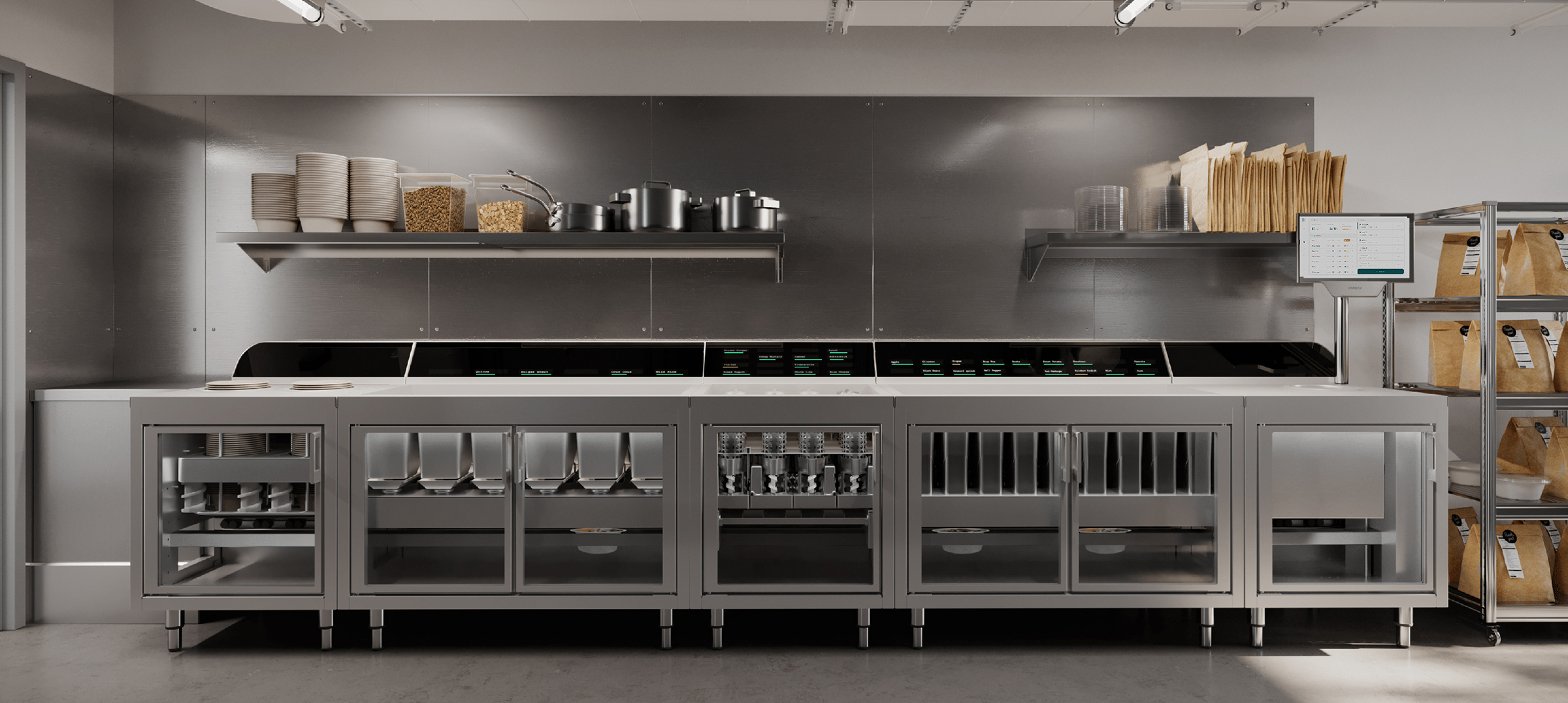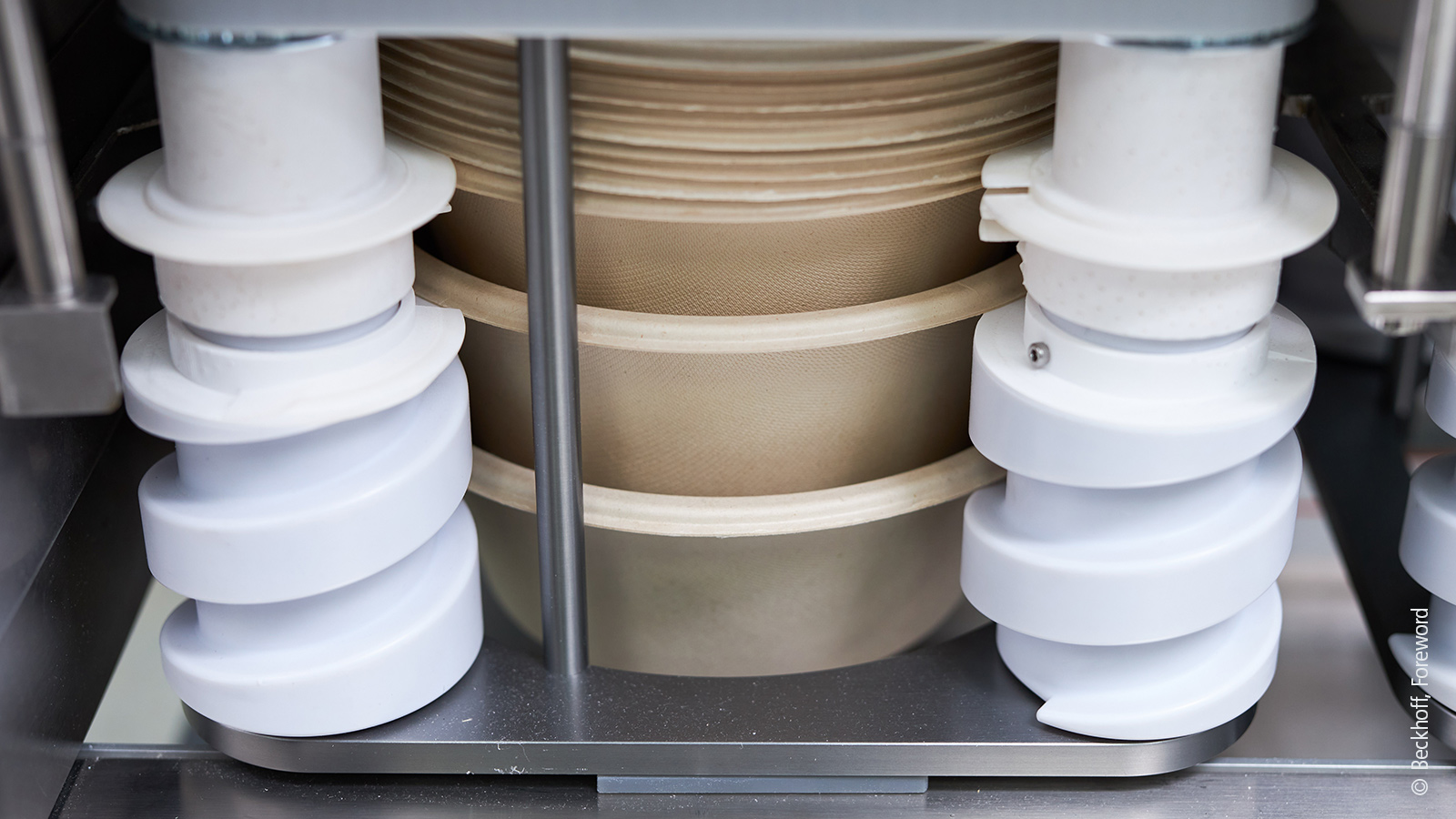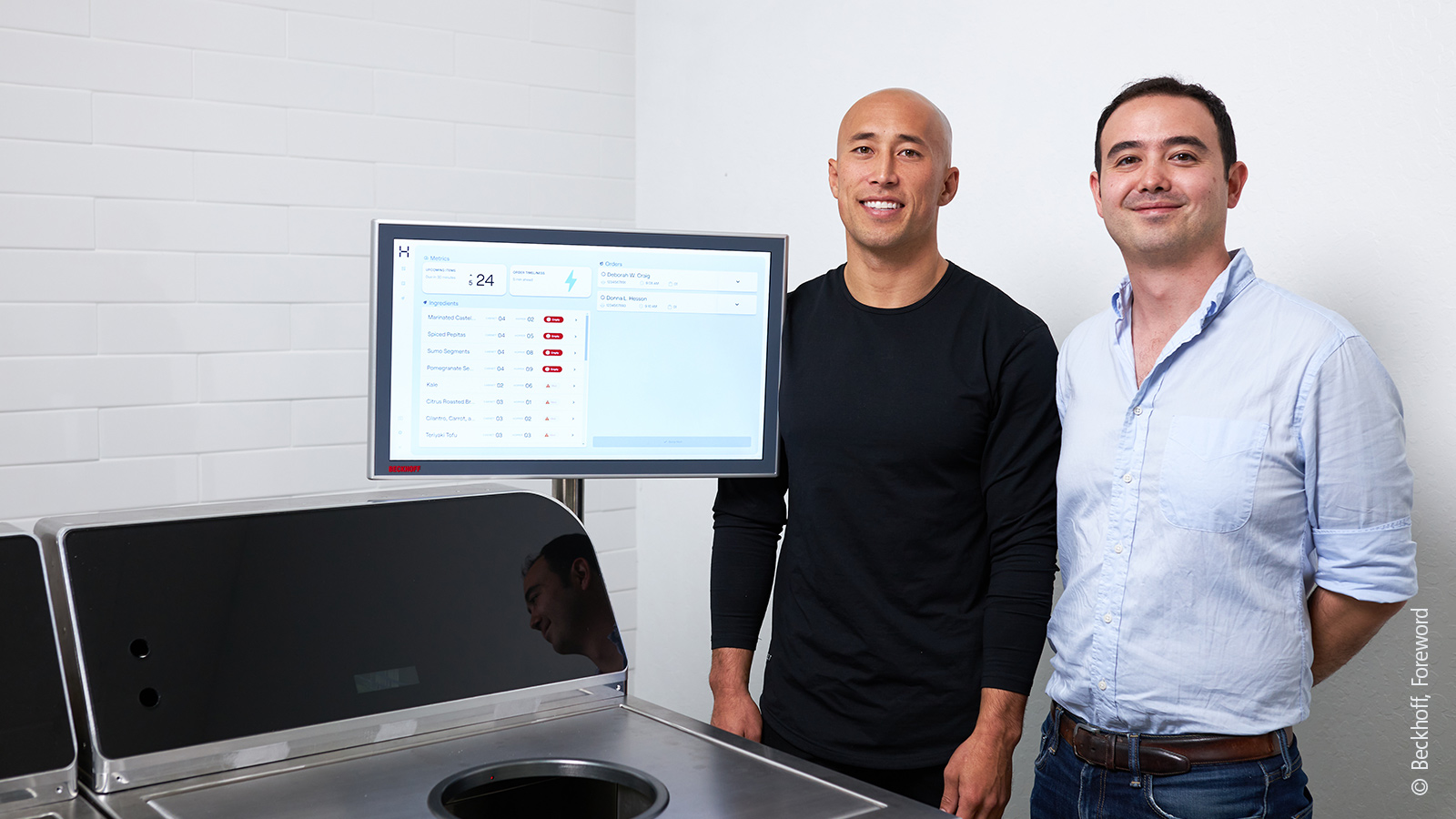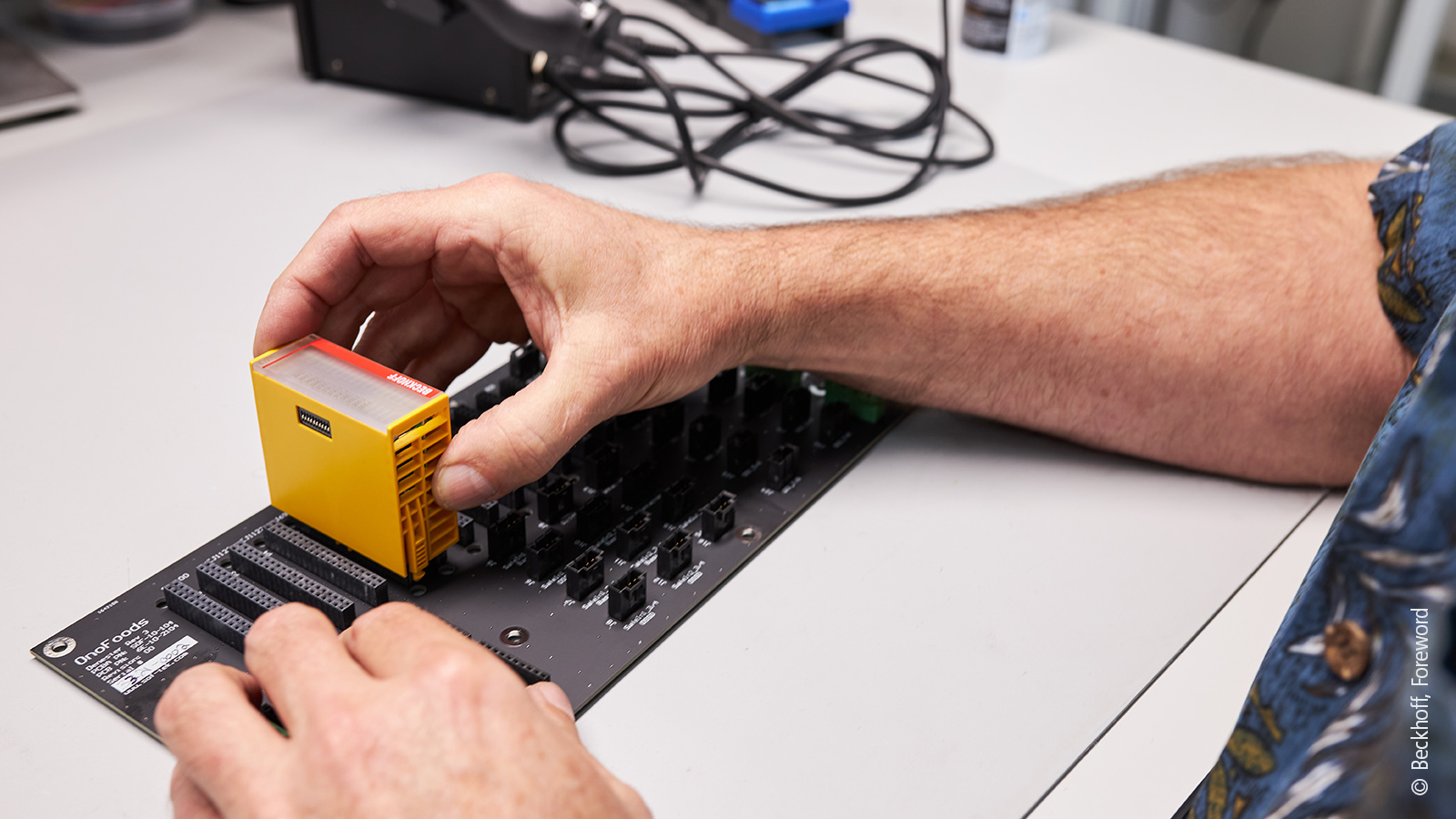

Digitization of foodservices with EtherCAT and PC-based control technology
The Makeline from Hyphen closes the gap between traditional and industrial food preparation. The compact machine enables fast fulfillment of digital orders – in the kitchen of a delivery service, but also in restaurants with a storefront. The EtherCAT plug-in modules of the EJ series – designed for compact installation on a customer-specific signal distribution board – ensure functional safety, among other advanced features. The open control technology from Beckhoff enables seamless communication from the PLC to the cloud.
“Hyphen’s goal is to put foodservice operations on autopilot,” says Daniel Fukuba, Co-Founder and CTO of Hyphen based in San Jose, California. “We founded the business in July 2018 to leverage automation technology in modern restaurants. During the Covid-19 pandemic, we designed our new Makeline system. This provides restaurants – whether they’re established chains, foodservice providers or ghost kitchens – with the infrastructure to modernize business models, adapt toward digital-first ordering and be more resilient to the constant change we see today.”

The Makeline assembles salads and other menu items served in a bowl, handling hundreds of ingredients at various temperatures. The system connects to Hyphen’s cloud services to route digital orders via MQTT. After receiving an order, the Makeline system activates dispensers developed by Hyphen to fill the bowls, conveying them through connected modules inside the enclosure. The machine also controls food safety and provides data insights about peak ordering times and customer habits. From the outside, however, it looks like a traditional kitchen makeline, and restaurant staff can still load in ingredients and serve customers manually who prefer to order in person.
Clean control architecture helps satisfy customer appetite
Hyphen wanted the Makeline to fit into existing restaurant facilities, adding tomorrow’s technology to today’s kitchens. That meant designing a new system to fill the gap between traditional restaurant kitchens and industrial food preparation. One reason why is that from a technical standpoint, it’s very difficult to balance the necessary capabilities and flexibility in a form factor small enough for standard kitchens.
The Makeline must fit more than 70 actuators, plus the cloud-connected controls and I/O, into what is essentially a restaurant-grade kitchen appliance. In addition to minimizing footprint, the system needed to meet hygienic standards, and Hyphen also wanted it to provide process controls, time and temperature holding information and the ability to audit and log the food storage environment. The machines would need to accommodate 500 different ingredients, which all interact differently depending on the menu item. Hyphen wanted to solve these material handling challenges while avoiding an excess of instrumentation to control the process while maintaining a clear overview.

In early 2020, Hyphen started to explore EtherCAT and PC-based control technologies from Beckhoff. “The Makeline’s requirements called for open, easy-to-interface systems,” says Bradley Hwang, Controls Engineer at Hyphen. “Beckhoff made it easy to enable seamless communication interfaces from the PLC runtime up to the cloud. So our software team can develop a completely new layer between that and third-party services.”
EtherCAT helps automate foodservices industry
Each Makeline module features pluggable EtherCAT TwinSAFE I/O technology of the EJ series for functional safety, which mount to a custom-design PCB board – the signal distribution board. These pluggable EJ modules are roughly 50% smaller than traditionally wired I/O terminals and, in addition, reduce potential wiring errors.
“Most industrial electrical cabinets with this amount of I/O are massive, but that wasn’t an option for this product. With the EJ series TwinSAFE modules, we could connectorize communication, power supply and more together on a space-saving circuit board that offers easier, more repeatable assembly,” Bradley Hwang explains. “Also, as a member of the EtherCAT Technology Group (ETG), Hyphen took advantage of the openness of the EtherCAT technology to create our own secondary nodes. So not only can we select from the massive number of EtherCAT devices on the market, but we can also build exactly what we need for the Makeline when needed.”
Control software and hardware serve up performance
TwinCAT 3 automation software supports a variety of programming methods – from the object-oriented extensions of IEC 61131-3 to premade and custom function blocks up to computer science standards in Visual Studio. This made it easier for Hyphen to bridge the gap between its controls and app-development technologies.

The Makeline relies on one ultra-compact C6030 Industrial PC (IPC) for all operations. TwinCAT offers core-isolation capabilities to optimally utilize system performance by designating individual processes in the quad-core CPU, such as PLC or IoT, to one specific core in the IPC. So the C6030 is ideal for use as an IoT gateway as well as a machine controller.
The C6030 resides in a base cell with an IP65-rated, customer-specific CP3924 multi-touch Control Panel, with customizable branding optionally available. The 24-inch, pole-mounted operating unit provides a premium user interface, according to Daniel Fukuba: “We develop our HMI screens like modern web apps, so the multi-touch capabilities and display fidelity give us the responsiveness that we want in our UI. This user-friendliness means any restaurant employee can operate the Makeline – you don’t have to be a trained machine operator.”
A recipe for disruption
Hyphen began conceptualizing the Makeline in mid-2020, with its first units scheduled to arrive at customers by the end of 2021. The machines can produce 350 meals per hour with 99% order accuracy, and it improves portioning precision from the industry average of +/-15% down to +/-2%. “Having the wrong ingredients in an order is annoying at best but life threatening at worst considering food allergies and cross-contamination, so those are critical benefits,” Daniel Fukuba says.
The control hardware, IoT and networking technologies from Beckhoff helped Hyphen deliver the technical capabilities while meeting footprint requirements. “We believe the Makeline has the potential to disrupt the industry. It increases the capacity of restaurants’ current staff by a factor of 17, which fundamentally changes how they meet their demand and how they can increase their capacity to sell more,” Daniel Fukuba explains. “By effectively digitizing food, it’s possible to fill in the gaps for the entire industry and be ready for whatever comes next.”